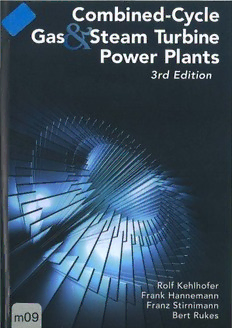
Combined-cycle gas & steam turbine power plants PDF
Preview Combined-cycle gas & steam turbine power plants
Combined-Cycle Gas Steam Turbine Power Plants Combined-Cycle Gas ~am Turbine Power Plants BRITISH LIBRARY DOCUMENT SUPPLY CENTRE 06 MAY 2003 m09/. - - 20650 Rolf Kehlhofer ;~ PennWelr Bert Rukes Frank Hannemann ~ Franz Stirnimann Disclaimer: The recommendations, advice, descriptions, and the methods in this book are presented solely for educational purposes. The author and publisher assume no liability whatsoever for any loss or damage that results from the use of any of the material in this book. Use of the material in this book is solely at the risk of the user. Copyright © 2009 by PennWell Corporation 1421 South Sheridan Road Tulsa, Oklahoma 74112-6600 USA 800.752.9764 11.918.831.9421 [email protected] www.pennwellbooks.com www.pennwell.com Marketing: Jane Green National Account Executive: Barbara McGee Director: Mary McGee Managing Editor: Stephen Hill Production Manager: Sheila Brock Production Editor: Tony Quinn Cover Designer: Jesse Bennett Book Designer: Susan Ormston Library of Congress Cataloging-in -Publication Data Combined-cycle gas & steam turbine power plants / Rolf Kehlhofer ... let al.]. -3rd ed. p.cm. Rev. ed. of: Combined-cycle gas & steam turbine power plants / Rolf Kehlhofer. Includes bibliographical references and index. ISBN 978-1-59370-168-0 (alk. paper) 1. Gas power plants. 2. Cogeneration of electric power and heat. 3. Steam power plants. I. Kehlhofer, Rolf, 1951-Combined-cycle gas & steam turbine power plants. II. Title: Combined cycle gas and steam turbine power plants. TKI061.K442008 621.31'2132-dc22 2008043560 All rights reserved. No part of this book may be reproduced, stored in a retrieval system, or transcribed in any form or by any means, electronic or mechanical, including photocopying and recording, without the prior written permission of the publisher. Printed in the United States of America 1 2 3 4 5 13 12 11 10 09 Contents 1. Introduction 1 2. The Electricity Market 5 3. Economics 11 4. Thermodynamic Principles of the Combined-Cycle Plant 35 5. Combined-Cycle Concepts 45 6. Applications of Combined Cycles 135 7. Components 165 8. Control and Automation 211 9. Operating and Part Load Behavior. 225 10. Environmental Consideration. 261 11. Developmental Trends 277 12. Integrated Gasification Combined Cycle 287 13. Carbon Dioxide Capture and Storage 321 14. Typical Combined-Cycle Plants 349 15. Conclusion 389 Appendix A: Conversions Table 393 Appendix B: Calculation of the Operating Performance of Combined-Cycle Installations 403 Appendix C: Symbols Used 405 Bibliography 407 Index 413 About the Authors 433 List of Fig u res Figure 1-1 Simplified flow diagram of a combined cycle 2 Figure 2-1 Market development since 1975 of new power plants sold per year 9 Figure 3-1 Breakdown of the capital requirement for combined-cycle power plant 19 Figure 3-2 The cost of fuels over the years 23 Figure 3-3 Comparison of cost of electricity for base-load operation 29 Figure 3-4 Comparison of cost of electricity for intermediate load 30 Figure 3-5 Influence of fuel cost on the cost of electricity 31 Figure 3-6 Influence of the equivalent utilization time on the cost of electricity 32 Figure 3-7 Influence of interest rate on the cost of electricity 32 Figure 4-1 Temperature/entropy diagrams for various cycles 37 Figure 4-2 Gas turbine inlet temperature (TIT) definitions 38 Figure 4-3 The efficiency of a simple-cycle GT and a combined cycle plant as function of the gas turbine inlet temperature and pressure ratio 42 Figure 4-4a The efficiency of a simple-cycle GT with single-stage and4-4b combustion as a function of turbine inlet temperature (TIT) and turbine exhaust temperature 43 Figure 4-5a The efficiency of a simple-cycle GT with sequential and 4-5b combustion as a function of the turbine inlet tempera- ture (TIT) and the turbine exhaust temperature 44 Figure 5-1 Selection of a combined-cycle power plant concept 46 Figure 5-2 Evolutionary change in combined-cycle design philosophy 47 Figure 5-3 Standardization approach 48 Figure 5-4 Entropy/temperature diagram for a gas turbine process at two different ambient air temperatures 52 Figure 5-5 Relative efficiency of gas turbine, steam process, and combined cycle as function of the air temperature 53 Figure 5-6 Relative power output of a gas turbine, steam turbine, and combined cycle as function of the air temperature 54 viii Combined-Cycle Gas & Steam Turbine Power Plants Figure 5-7 Relative power output of gas turbine, steam turbine, combined cycle, and relative air pressure versus elevation above sea level 55 Figure 5-8 Relative power output and efficiency of gas turbine and combined cycle as function of relative humidity 56 Figure 5-9 Effect of water and steam injection on relative combined-cycle power 59 Figure 5-10 Effect of condenser pressure on steam turbine output 62 Figure 5-11 Temperature of cooling medium versus condenser pressure for different types of cooling systems 63 Figure 5-12 Flow diagram to show fuel preheating 65 Figure 5-13 Steam turbine output and HRSG efficiency versus gas turbine exhaust temperature for a single-pressure cycle 68 Figure 5-14 Ratio of steam turbine output of a dual pressure compared to a single-pressure cycle as a function of the gas turbine exhaust temperature 69 Figure 5-15 Energy/temperature diagram for an idealized heat exchanger 71 Figure 5-16 Flow diagram of a single-pressure cycle 73 Figure 5-17 Energy/temperature diagram of a single-pressure HRSG 75 Figure 5-18 Heat balance for a single-pressure cycle 76 Figure 5-19 Energy flow diagram for the single-pressure combined-cycle power 77 Figure 5-20 Effect of live steam pressure on steam turbine output for a single-pressure cycle (including steam turbine exhaust moisture content and HRSG efficiency) 78 Figure 5-21 Energy/temperature diagram of a single-pressure HRSG with live-steam pressure of 40 and 105 bar (566 and 1508 psig) 79 Figure 5-22 Effect of live-steam pressure on condenser waste heat at constant condenser pressure 80 Figure 5-23 Effect of live-steam temperature on steam turbine output for a single-pressure cycle with 105 bar (1508 psig) live-steam pressure (including HRSG efficiency and steam turbine exhaust moisture content) 82 Figure 5-24 Effect of pinch point on relative steam turbine power output and relative HRSG heating surface 83
